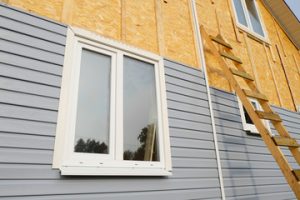The best time to inspect your siding is in spring, when mild temperatures make it easier for contractors to work and lessen the chances of weather delays. This allows the replacement process to be completed before summer storms hit and cause additional damage.
Generally, repair is more cost-effective than replacement. However, it all depends on the type and extent of the damage. It’s recommended to consult with Charleston Siding Pros experts.

Damaged Panels
It’s important to address damaged siding panels as soon as possible. This helps minimize moisture infiltration, which can lead to rot, mildew, and other structural damage. It also allows you to save on heating and cooling costs by keeping your home properly insulated.
Look for visual cracks or chips on your siding, as well as faded areas. In some cases, a single fading panel may be easy to repair with a little paint. However, if you notice these issues across the house, it may be time to consider a full replacement.
Vinyl is especially prone to cracking, whether from heavy hail or running over it with your lawnmower. These cracks provide entryways for moisture, rodents, and other pests to damage the rest of your home’s exterior.
Even wood isn’t immune to this type of damage, as it can warp when exposed to heat and humidity. This warping can leave dents that are difficult to fix with paint or caulking alone.
In addition to these visual signs of damage, you should watch out for a swollen or bowed appearance on your siding. This is a sure sign that water is trapped in the siding, which can eventually lead to mold, mildew, and other moisture problems inside your home. Swollen or bowed areas should be assessed by a professional to determine the best course of action.
Missing Panels
Generally, the size and severity of siding damage dictate whether repair or replacement is necessary. Repairs cost less than full replacement but are only a temporary solution. They also only address one or a few damaged panels at a time, leaving the rest of your home vulnerable to weather and pests.
If you spot a recurring pattern of missing panels, it’s a good idea to contact a professional. Even small areas of missing or cracked siding can allow moisture to enter your home’s sheathing and walls, leading to serious issues like mold and mildew growth and structural problems.
Wood and vinyl siding can both deteriorate over time due to age, harsh weather conditions, and pest infestations. If you notice signs of rot, warping, or fading, this may be an indication that it’s time for replacement.
Choosing the right time to replace your siding can help you save money and avoid costly complications down the road. It’s important to understand that re-siding is a major project, so it should only be done when you have the time to dedicate to it. It’s also smart to remove any outdoor furniture or other items from your home that could get in the way of the installation process. In addition, you’ll want to trim any overhanging trees or shrubs that could damage the siding during installation.
Cracked or Warped Panels
Siding acts as your home’s first line of defense against the elements, and it enhances your property’s curb appeal. If your siding is cracking or warping, it’s important to contact a reputable contractor as soon as possible. Unaddressed warping or cracking leaves your home vulnerable to moisture penetration, which can cause rot and structural damage that requires costly repairs.
Over time, aging, weather, and impact can cause your vinyl or other type of siding to develop cracks, chips, and warps. These blemishes may seem cosmetic at first, but they open the door to further issues that can be much more costly and damaging to your home.
Moisture seeping in through cracks and warping allows rot and unhealthy mold to grow, which can lead to a host of other problems like increased energy bills and health risks for you and your family. It can also damage the interior of your home, including the flooring and insulation, resulting in additional costs and extensive repair work.
It’s a good idea to contact a professional as soon as you notice any signs of cracking or warping in your vinyl or other types of siding. For minor warping, you may be able to soften the material with a little heat and reshape it as needed, but removing the affected panel is often the best option.
Leaking Panels
Whether they’re caused by high winds or carpenter ants, any loose or peeled siding panels should be repaired ASAP. Gaps allow rain to pour in and damage the walls, insulation, and framing behind them. This moisture can rot wood and cause mold, mildew, and other issues in your home’s interior.
Check the areas around windows and doors for cracks, soft spots, and peeling paint. Cracked caulking and gaps in frames let water sneak in where the outer and inner layers of your siding meet. Look for signs of insect infestations in these areas, too – carpenter ants and other woodpeckers thrive in damp, moldy environments.
Any signs of mold, mildew, or dark streaks along the bottom of the siding are a clear sign of rot and chronic dampness. If the problem has been going on for some time, the rotting or dampness can even affect the structural integrity of your house. Energy bills can also spike when moisture compromises your siding and insulation.